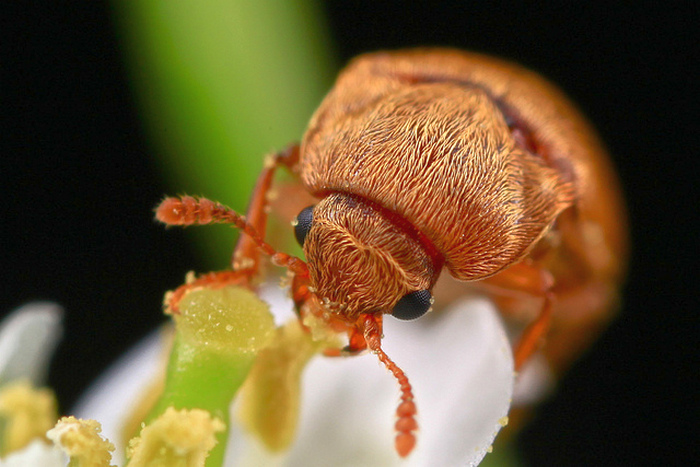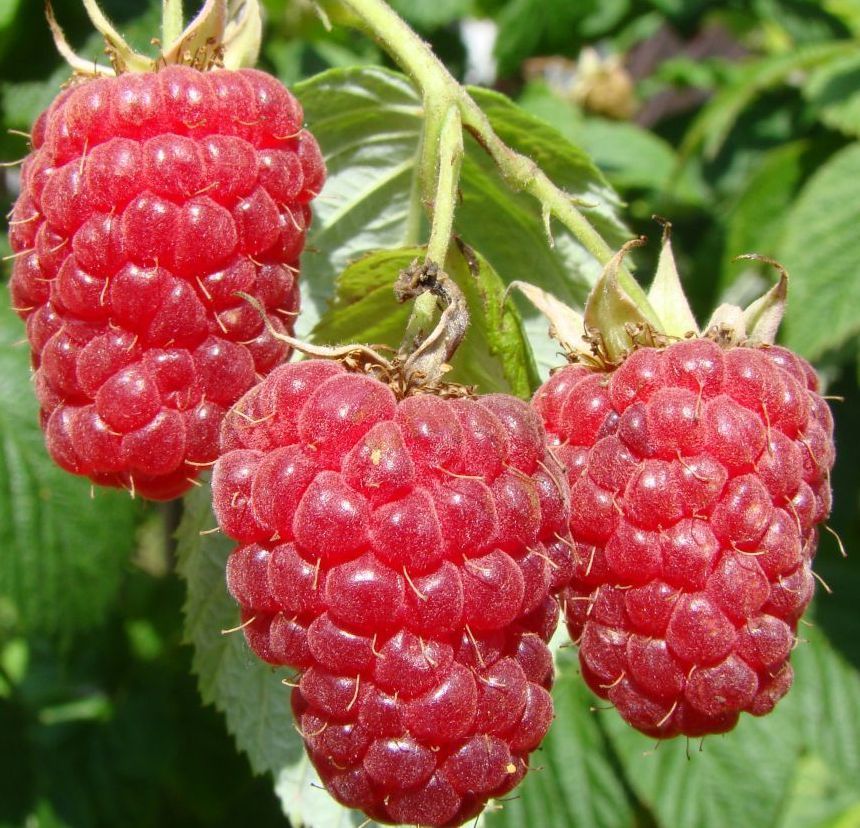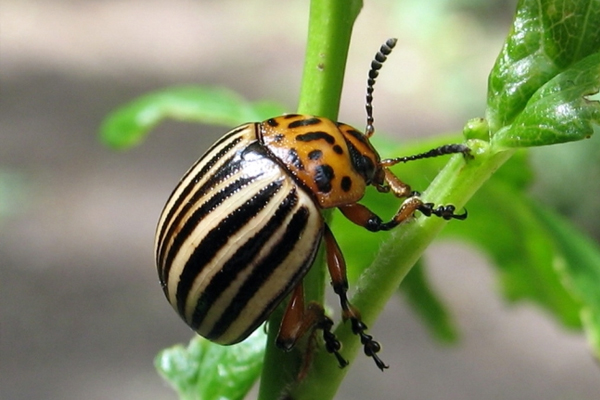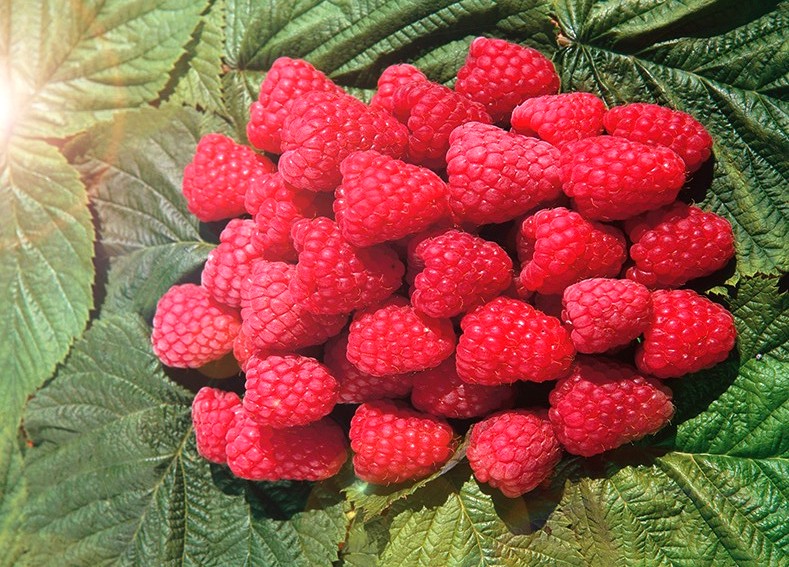Content:
Pests cause a lot of trouble for gardeners. To preserve a fruitful berry, you need to know how to deal with harmful insects. Raspberry beetle, weevil, bug, raspberry fly, spider mite can harm berry bushes. We will present a description of insects, methods of control, what to do if the raspberry is wormy.
Description of the raspberry beetle
The pest insect that harms the berry bushes is called the raspberry beetle. In its natural environment, the raspberry beetle can settle on the bushes of forest raspberries, but it is just as dangerous for high-quality raspberries at their summer cottage.
A small bug can leave gardeners without raspberries. It is necessary to fight the pest using complex measures.
It is very difficult to notice the appearance of a raspberry beetle at the initial stage, a small insect is well camouflaged. Settling on raspberry leaves, the beetle begins to lay eggs on flowers and ovaries. The size of an adult insect is 4 mm. The beetle is light brown or yellow in color, the body is covered with fine hairs.
After mating, the raspberry beetle lays eggs, from which larvae soon emerge. In appearance, they resemble a white worm. They grow in length up to 7 mm, the skin is covered with hairs. The larvae eat ripe raspberries, thereby spoiling their taste characteristics and marketable appearance. If the raspberries are shriveled and begin to deteriorate, then the bushes are affected by the raspberry beetle.
With the onset of spring, the bugs are activated. When the soil warms up to 12 degrees, they crawl out of the ground and get close to the raspberry bushes. As the foliage grows, the raspberry beetle eats the young leaves. Beetles move on the ground and in the air, they fly freely from bush to bush. If raspberries do not grow nearby, then they move to garden trees.
The flower in which the larva develops begins to wither and deform. In 1.5 months, caterpillars can completely damage the crop. After they descend and burrow into the ground to a depth of 20 cm. Having buried in the ground, the larvae hibernate, the next year they pupate and again crawl out to the surface already in the form of a bug.
Control methods
An integrated approach is used to combat the raspberry beetle. Beetles are dangerous because they can completely destroy the crop, and in the new season they will again infect plants.
Biological and chemical methods of prevention against insect pests are used. If you use only chemicals, then this may be an ineffective way - the berry will be poisoned with chemicals.
To save the crop, the first thing to do is to prevent insect breeding. Raspberry fly, fighting it:
- Before flowering, raspberry bushes are covered with gauze net. This will reduce the beetle's contact with flowers;
- If a raspberry beetle was found while picking berries, then the crop is washed in slightly salty water. The larvae will crawl out of the pulp and can be collected;
- Cover the holes around the bushes with non-woven material. Mulch will prevent the larvae from penetrating the ground for the winter. Agrospan, spunbond are used for mulching;
- Beetles are afraid of ash and manure. Regular feeding and dusting the soil with ash will help scare off the pest;
- Thinning bushes is a measure of insect prevention;
- The beetles feed on raspberry leaves.The bushes are treated with Bordeaux liquid, this prevents fungal diseases, impairs the taste of the leaves;
- Beetles do not tolerate acidic soil, so the soil can be acidified with coniferous sawdust;
- In the spring, the soil around the bush is dug up, filling up the beetle's burrows. It is necessary to dig carefully, there is a risk of damaging the roots;
- The bushes are recommended to be regularly examined for pests. If a beetle is found, it must be shaken off into a bucket or on a newspaper and destroyed. In the morning and evening hours, the raspberry beetle is lethargic, easier to collect;
- Till the soil in autumn. The earth is powdered with tobacco dust. Weeds in the area where raspberries grow must be removed by the roots.
Preparations against the raspberry beetle
To combat the raspberry beetle, chemical and biological preparations are used.
Insecticides against the raspberry beetle:
- Kinmix (2.5 ml per 5 liters of water);
- Karbofos (5 ml per 5 liters of water);
- Alatar (2 ml for 5 liters of water);
- Spark (1 tablet in 5 liters of water).
Biological preparations and folk methods:
- Bitobaxicillin - broad-spectrum insectofugicide. The drug reduces the number of beetles;
- Fitoverm (10 ml per 1 liter of water). The biological agent is allowed to be used during the fruiting period (June, July). The active substance of the drug does not affect the berries;
- Bushes are treated with a weak solution of potassium permanganate in early spring;
- Spray the bushes with tansy infusion. The grass makes the leaves bitter, the smell repels insects;
- Insist 300 g of tobacco in 5 liters of water for a day. Boil the solution, cool, strain. Dilute with water, add grated laundry soap, water the bushes with the resulting solution;
- The infusion of mustard powder repels the raspberry beetle. It is better to water raspberries in the morning or in the evening after sunset;
- Baking soda solution (10 g per 5 liters of water). Irrigation with baking soda will scare away the pest and improve the presentation of the berry.
Complex methods of dealing with the raspberry beetle will allow gardeners to save the berry.
Fight against raspberry flies, bugs and weevils
In addition to the crimson beetle, a crimson fly, a bug or a weevil can attack the bushes. If a pest attacks the area where raspberries grow, then the gardener will be left without a crop.
To combat raspberry stem fly, chemical and biological preparations, folk methods are used.
Aggressive drugs against raspberry fly:
- Actellik;
- Spark;
- Karbofos;
- Confidor.
- Biological agents:
- Agravertine;
- Fitoverm.
From folk remedies used Bordeaux mixture, soda solution.
Bed bugs (sorrel, green, woody, berry) threaten raspberry bushes. If dried berries appear, then this is the result of bedbugs working on raspberries. Adult insects feed on sap from the ovary, buds, leaves and berries.
To get rid of uninvited pests, an integrated approach is used to combat bedbugs. For the raspberry bug, drugs are used:
- Fufanon;
- Actellik;
- Spark;
- Kemiphos.
Weevils are a danger to raspberry bushes and strawberries. When laying beds for berries, it is recommended to place raspberries and strawberries away.
To prevent the defeat of the bushes with a weevil, it is necessary to carry out complex measures. Raspberry weevil control measures:
- Inspection of the bush. Each time, collect and destroy fallen leaves, buds;
- In autumn, dig up the area where raspberries grow;
- Spread the film in early spring, shake off all the beetles from the bushes and burn them;
- Application of special traps for the raspberry-strawberry weevil.
Folk ways:
- Infusion of onions and celandine;
- Tansy decoction;
- A mixture of laundry soap, mustard and water;
- You can plant garlic next to the garden bed where raspberries grow, this will scare away the weevil.
Raspberry processing as prevention of worms in berries
The worm spoils ripe raspberries. To protect raspberry bushes from worms, preventive measures must be taken. The way how you can process raspberries in the spring from worms:
- In early spring, the bushes are watered with hot water (80 degrees). It is recommended to pour over the bushes and the ground;
- In autumn, the area with raspberries must be dug up, the remnants of weeds must be removed, the soil must be mulched. Humus, peat, sawdust, compost are used as a mulching material. Worms living on the soil surface cannot get out from under the mulch layer;
- During the flowering period, worms can be harvested by hand. The surest way to quickly remove worms from raspberries and clear all bushes is to spread the film on the ground and shake the raspberry bushes. Gently collect and burn the fallen worms;
- A popular way to treat raspberries from worms in berries: the bushes are sprayed with a soda solution (10 g soda plus 5 liters of water) or mustard infusion.
Pests can seriously harm the grower. They can damage raspberry bushes, spoil the harvest. Therefore, it is important in the spring and summer periods to carefully inspect the bushes and, when insects appear, to destroy them in a timely manner. Knowing how to get rid of worms in raspberries, weevils, flies, bedbugs, you can grow a large harvest of fragrant tasty berries.















